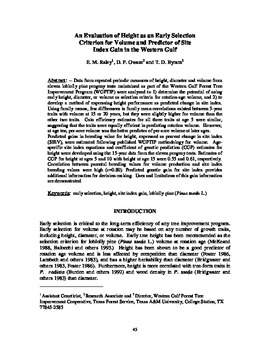| dc.contributor.author | Raley, E. M. | |
| dc.contributor.author | Gwaze, D. P. | |
| dc.contributor.author | Byram, T. D. | |
| dc.date.accessioned | 2016-04-25T19:35:56Z | |
| dc.date.available | 2016-04-25T19:35:56Z | |
| dc.date.issued | 2003 | |
| dc.identifier | oksd_sf27_p045.pdf | |
| dc.identifier.citation | Raley, E. M., Gwaze, D. P., & Byram, T. D., (2003). "An Evaluation of Height as an Early Selection Criterion for Volume and Predictor of Site Index Gain in the Western Gulf." In 27th Southern Forest Tree Improvement Conference, Stillwater, OK | |
| dc.identifier.uri | https://hdl.handle.net/11244/33658 | |
| dc.description.abstract | Data from repeated periodic measures of height, diameter and volume from eleven loblolly pine progeny tests maintained as part of the Western Gulf Forest Tree Improvement Program (WGFTIP) were analyzed to 1) determine the potential of using early height, diameter, or volume as selection criteria for rotation-age volume, and 2) to develop a method of expressing height performance as predicted change in site index. Using family means, few differences in family mean correlations existed between 5-year traits with volume at 15 or 20 years, but they were slightly higher for volume than the other two traits. Gain efficiency estimates for all three traits at age 5 were similar, suggesting that the traits were equally efficient in predicting rotation volume. However, at age ten, per-acre volume was the better predictor of per-acre volume at later ages. Predicted gains in breeding value for height, expressed as percent change in site index (SIBV), were estimated following published WGFTIP methodology for volume. Age specific site index equations and coefficient of genetic prediction (CGP) estimates for height were developed using the 15-year data from the eleven progeny tests. Estimates of CGP for height at ages 5 and 10 with height at age 15 were 0.55 and 0.61, respectively. Correlation between parental breeding values for volume production and site index breeding values were high (r=0.80). Predicted genetic gain for site index provides additional information for decision-making. Uses and limitations of this gain information are demonstrated. | |
| dc.format | application/pdf | |
| dc.language | en_US | |
| dc.relation.ispartofseries | Sponsored publication . . . of the Southern Forest Tree Improvement Committee ; no. 49 | |
| dc.rights | This paper is made available through open access and the auspices of the fair use doctrine for scholarly, educational and research purposes while recognizing the publisher already offers a free online version. The OSU Library�s intent is to offer access and preserve publications involving its faculty contributions. Contact the Digital Resources and Discovery Services at lib-dls@okstate.edu or 405-744-9161 for the permission policy on the use, reproduction or distribution of this material. | |
| dc.source | Proceedings of the 27th Southern Forest Tree Improvement Conference, volume 27, 2003. Editor, Craig R. McKinley. | |
| dc.title | Evaluation of Height as an Early Selection Criterion for Volume and Predictor of Site Index Gain in the Western Gulf | |
| dc.type | text | |
| osu.filename | oksd_sf27_p045.pdf | |
| dc.type.genre | Conference proceedings | |
| dc.subject.keywords | early selection | |
| dc.subject.keywords | height | |
| dc.subject.keywords | site index gain | |
| dc.subject.keywords | loblolly pine (pinus taeda l.) | |
| dc.description.scopeandcontents | Papers and abstracts from the 27th Southern Forest Tree Improvement Conference held at Oklahoma State University in Stillwater, Oklahoma on June 24-27, 2003. | |
